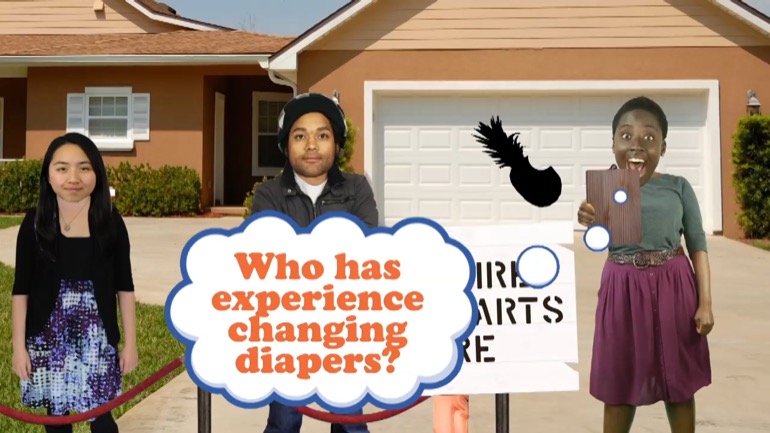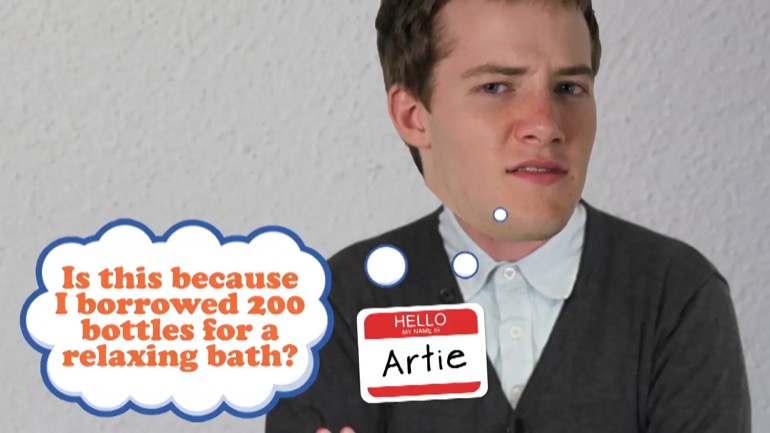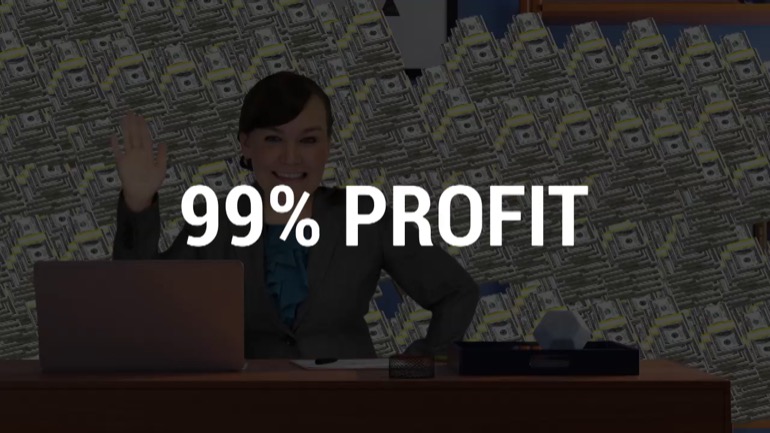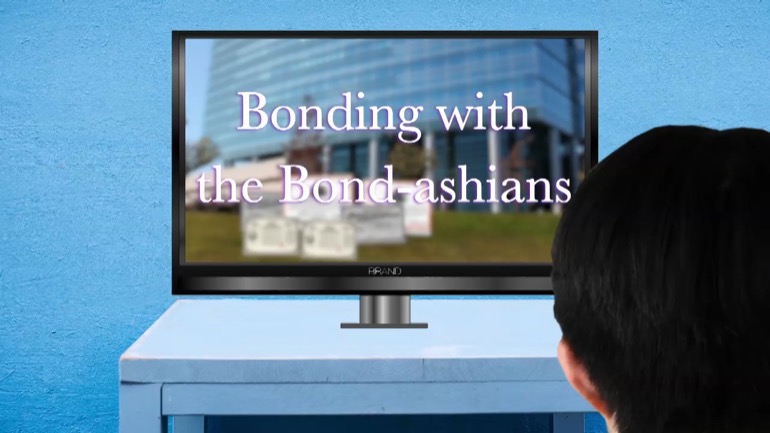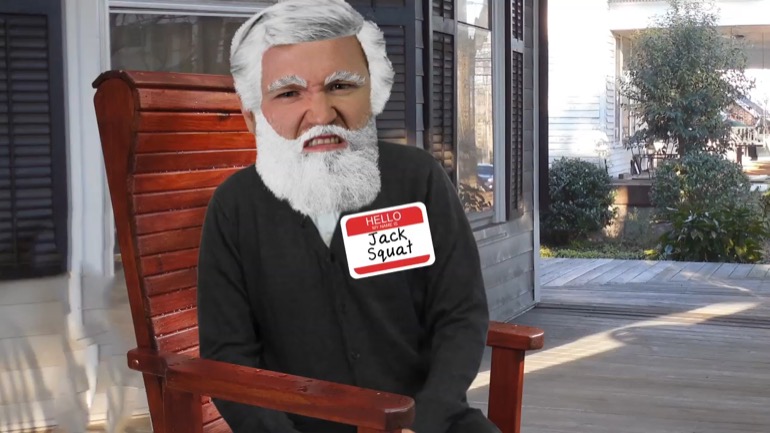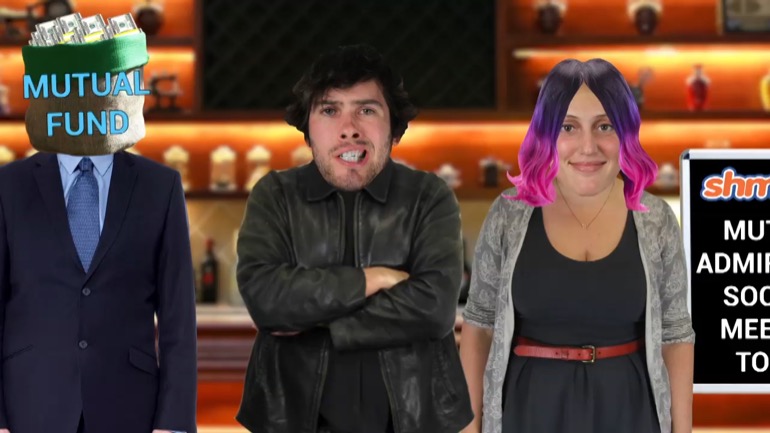ShmoopTube
Where Monty Python meets your 10th grade teacher.
Search Thousands of Shmoop Videos
Principles of Finance Videos 166 videos
How is a company... born? Can it be performed via C-section? Is there a midwife present? Do its parents get in a fight over what to name it? In thi...
Company Formation, Structure, and Inception: Unit Intro. Sorry, Leo DiCaprio fans—we're not going to be breaking down the plot of Inception. We'r...
Okay, so you want to be a company financial manager. It's basically up to you to make money for the shareholders. It would also be swell if you mad...
Principles of Finance: Unit 1, Share Buybacks and Dividends 41 Views
Share It!
Description:
Our little lemonade stand got started with a $5,000 loan. What to do now? Pay off the loan or franchise with the profits? What a "Sophie's Choice" we have on our hands here.
Transcript
- 00:00
Principles of finance a la shmoop share buybacks and dividends
- 00:06
well when companies are so profitable that they're just swimming in cashola [Company briefcase in a pool of cash]
- 00:11
they start to think about directly giving back some of that excess cash to
- 00:16
investors you know excess in quotes there now when you think about that much
- 00:20
cash well you have to imagine a company that sells a bottle of whatever for [man discussing company selling sauce]
Full Transcript
- 00:24
eight bucks each and that bottle cost them two dollars to make and $1 to
- 00:28
distribute the remaining overhead and everything else cost some 50 cent so
- 00:32
on the back at the envelope income statement at least at a unit level looks
- 00:35
about like this and then they pay taxes and let's call taxes a buck fifty for
- 00:40
now to make the illustration easy and yeah you get three dollars in that
- 00:44
profit there that's pretty good so this company has three eighths or
- 00:47
37.5 percent net profits very high profit margin must be
- 00:52
great whatever in those bottles now imagine that the company not only has no
- 00:57
debt but it also has tons of cash on the books in fact enough cash to run the [Sauce dropping into a bottle]
- 01:01
company for five years at this level of expense even with no revenues they have
- 01:06
ample room to make acquisitions and since they pay such high tax rates well
- 01:11
they could borrow money really cheaply right after taxes interest on borrowed
- 01:14
money is deductible so it's time to consider what to do with that wonderful [Company swimming in cash]
- 01:18
cash hoard well generally speaking there are two ways in which that cash gets
- 01:23
returned to shareholders you know the people who own the company these days
- 01:27
are well number one share buybacks and yes companies buy back their own stock
- 01:31
all the time now that used to be unheard of in the 1960s and 70s because thing a [People protesting for stocks]
- 01:37
dividend was almost mandatory to be considered a "blue chip stock"
- 01:41
and in Europe share repurchase was almost tax prohibitive because the
- 01:45
repurchasing was taxed as if it was the company realizing a large investment
- 01:50
game so European companies really never bought back their own stock and kind of
- 01:54
still don't really today but in the US companies eat their own financial [Man with company briefcase for head eating cash at a table]
- 01:58
cooking and when they think their prospects for the future are good and
- 02:02
the market believes them to be bad as evidenced by low multiple stock prices
- 02:07
well, companies hold up couple of fingers and they ask the street to read
- 02:11
between the lines they have to announce their plans well
- 02:13
in advance and give dollar amounts for targeted buy back so everyone knows what
- 02:17
they're doing nothing sneaky here then the companies have to live under strict
- 02:21
rules for the buyback as well only so many shares per day per week per month [Man discussing buy back rules]
- 02:25
and no more than X percent of the total shares traded in a given day week month
- 02:29
and all that brokerages handle the trades and have all kinds of
- 02:33
mathematical alerts so that they don't violate any of these covenants and that
- 02:37
makes sense right like a company wouldn't purposely put out a bad
- 02:40
earnings report or at least try to to crash their stock then buy back a whole [Company share price appears]
- 02:44
bunch of it to have fooled the street for all the people who sold and then
- 02:47
feel like fools afterwards right okay well there's a simple back of the
- 02:50
envelope math that many companies do to frame whether or not the buyback really
- 02:54
makes sense although there are really no rules here that are structured but for
- 02:58
starters think about it this way if a company has more cash on its books and [Cash stored in a vault]
- 03:01
it knows what to do with and that cash is sitting in the corporate Bank of
- 03:05
America account earning just 1% a year while the company will ask its financial
- 03:09
manager, how can we do better and how much better and the financial
- 03:14
manager will start the answer by saying something like well our stock is at [Financal manager discussing stock]
- 03:18
fifteen dollars a share we have five dollars a share in cash and no debt and
- 03:22
business is looking good will earn a dollar...we'll stop talking like
- 03:26
that we'll earn dollar in cash this year
- 03:28
and very likely meaningfully more than a dollar a share next year and the next
- 03:32
like a buck twenty-five and a buck fifty I think we should be trading at twenty
- 03:36
five dollars a share or more... excellent answer from your wily CFO
- 03:41
without the weird accent their, like a surfer dude all right well at 15 bucks a
- 03:45
share with five bucks share in cash and no debt and no big capital expenditures
- 03:49
needed like a new tractor smelting factory since your current one is almost [Tractor explodes]
- 03:53
worn out because this one isn't... well you'd say that the equity value of your company is
- 03:59
ten bucks a share that is investors paying $15 share to buy your stock are
- 04:03
getting five dollars a share in cash and paying ten dollars a share for the
- 04:07
future earnings power of your company so you're gonna earn a buck a share this
- 04:11
year in cash meaning that it's a real dollar of cash earnings not some weird
- 04:16
accounting trick to pretend that it's a dollar of earnings when it's really only [Dollar appears from magicians hat]
- 04:20
for 30 cents or less that's one dollar of cash earnings for ten dollars of
- 04:24
equity value in the company well said another
- 04:27
way your company's equity is being valued for 10 times the cash earnings
- 04:33
this year if you bought back your stock at these prices while you're getting a
- 04:37
10 percent cash on cash return on your investment in buying your stock it's not [Man straining and explodes]
- 04:43
a lot to handle there go back you have already 5 bucks a share in cash you do
- 04:47
nothing with the cash it just sits there then next year well you'll have 6 bucks
- 04:51
a share maybe a tad more and the next year 7 bucks in cash and change and so
- 04:55
on whoop-dee-doo but if you bought back shares with all [hand takes back share]
- 04:58
the cash you generate this year well you'll still have 5 bucks a share in
- 05:02
cash which is more than ample to run your business and you'll have taken down
- 05:06
your total number of shares outstanding by a big number
- 05:09
how big a number well let's do the math well let's say you have a hundred
- 05:13
million shares outstanding we said you were trading at fifteen bucks a share so
- 05:17
you have a market capitalization of 1.5 billion and we said you had five hundred
- 05:22
million in cash on the books right five bucks a share times hundred million
- 05:26
shares that means the equity capitalization of your company is a
- 05:29
billion dollars in if you're gonna earn $1 a share this year well you'll earn a
- 05:33
hundred million dollars net of everything if you spent all hundred
- 05:37
million of cash earnings this year buying back stock at fifteen bucks a
- 05:40
share you will have bought back about six [People discussing buying back shares in meeting room]
- 05:43
point seven million shares well what does that mean for shareholders? well it
- 05:46
means that your shares outstanding will have declined from a hundred million to
- 05:50
a hundred minus six point seven equals ninety three point three million lots of
- 05:55
really good things happen when you can make this thing work
- 05:58
well one to earn a dollar a share you no longer need to earn a hundred million
- 06:03
dollars now you only need to earn ninety three point three million it's easier...Two,
- 06:07
the current owners still own the same company even the cash on the books
- 06:12
hasn't changed and you didn't dip into your cash savings to buy back stock [Cash appears in a vault]
- 06:15
you just used cash generated by current operations to buy back stock but now
- 06:21
there are fewer slices of the pie to go around pie same just thicker all right [A pie appears]
- 06:27
point three liquidity has declined that's a negative what does that mean
- 06:31
again well let's say you had only a small group of founders and investors [Founders and investors sat at a table]
- 06:35
who still owned a lot of stock at this point well say they collectively
- 06:39
owned 60% of it and none were sellers at 15 bucks a share so 60 million shares
- 06:44
stayed in the same hands they've always been in since the company was more or
- 06:48
less started you used to have 40 million shares that were traded like blackjack
- 06:52
cards in Vegas every day but you just bought back 6.7 million of them so now
- 06:58
instead of 40 million shares trading back and forth well you now have only 30
- 07:02
3.3 million you've just taken roughly 16.7% of the liquid shares out of the
- 07:09
market see that's the math right there and that's bad you want a lot of [Car pulls up at fast food drive-thru]
- 07:12
liquidity in your stock so the big funds can get in and get out easily all right
- 07:16
moving on point four well the odds of your stock appreciating probably got
- 07:20
better if you were just flat and earned a hundred million dollars the next year
- 07:25
now on a share base of just ninety three point three million shares that hundred
- 07:29
million dollars of net profits or net earnings turns out to be a dollar seven
- 07:34
a share not just a dollar if you stayed at fifteen bucks a share and still had
- 07:38
your 5 bucks a share in cash your price to earnings multiple just went down even
- 07:43
further from 10 that's the 10 bucks in equity over that dollar share earning to
- 07:49
now 10 over a dollar 7 in cash earnings or just nine point three times cash
- 07:53
earnings for the equity value of your company it's really cheap people all
- 07:57
right and 5 you have to believe that eventually the market will appreciate [Man discussing point 5]
- 07:59
your very cheap stock price and that you'll get paid for it like it'll go up
- 08:04
or a smart buyer will just want to buy you the whole company all right well [Person gives check for company]
- 08:08
either that outcome or you fire your investor relations person and remarket
- 08:12
the company the Wall Street with the I don't know a prettier cover on your
- 08:15
annual report all right well so that's share buybacks in a nutshell and that's [Nutshell cracks and buybacks appear]
- 08:20
one way companies return cash to shareholders and it can get all tricked
- 08:25
up like in the above example what if you bought back three hundred million
- 08:29
dollars worth of stock or what if you took out five hundred million dollars of
- 08:32
debt and use three hundred million of your cash so that at the end of the
- 08:36
buyback you've bought back eight hundred million dollars worth of stock at
- 08:40
fifteen bucks a share like it stayed there the whole time to reduce your
- 08:43
share count by eight hundred divided by fifteen equals 53.3
- 08:48
million to give you after that buyback 46.7
- 08:51
million shares outstanding right went from 100 to 93 to now 46 and change
- 08:57
at this point you'd have five hundred million dollars of debt and 200 million
- 09:01
of cash or 300 million in net debt and remember you'd have added expense to the
- 09:06
company in paying to rent the debt ie at five percent interest that's added an
- 09:10
expense of twenty five million dollars pre-tax to your costs but to earn a
- 09:14
dollar share at this point you only need to earn 46.7 million
- 09:18
dollars remember you had to earn a hundred million at the beginning and if
- 09:21
business just stays flat which is probably not very good but if it did and
- 09:25
you earned a flat hundred million dollars again well then you to earn over
- 09:29
$2 a share that's 100 million divided by the forty six point seven million shares
- 09:33
outstanding and that gives you two dollars in like 14 cents a share there
- 09:37
abouts okay well this is sort of the math of leveraged buyouts kind of sorta [Man discussing math of leverage buyouts]
- 09:42
anyway that's share buybacks and it's kind of new school, old school dividends
- 09:48
well historically companies felt owned by shareholders and felt obligated to [People trading stock for cash]
- 09:52
return cash directly to them don't necessarily act like that these days
- 09:56
well that was usually done in the form of quarterly dividends and the setup is
- 10:01
similar to the example we just went through boards would sit around a smoky
- 10:05
room and yeah people used to smoke a lot back in the day and note the fat load of [Man smoking a cigarette]
- 10:09
cash on their balance sheet while they were lighting up they look at projected
- 10:13
cash earnings over the next three four or five years and pick some number maybe
- 10:17
it was five percent of that cash earnings maybe it was 50 percent of that
- 10:21
cash earnings and they'd return it to the people who own the company yes the
- 10:25
shareholders how's that again all right the company is likely to earn 100
- 10:28
million dollars in cash this year after taxes the board wants to return twenty
- 10:32
percent or twenty million dollars to shareholders in the form of a dividend
- 10:36
paid quarterly that's five million dollars a quarter paid in cash in
- 10:40
dividends to shareholders of record of common stock and on a hundred million
- 10:45
shares outstanding that's a nickel a share in dividends or 20 cents in a year
- 10:49
if the stock was trading at fifteen bucks a share then the 20 cents over
- 10:53
fifteen dollars is the dividend rate get the decimal right because that's point [Dividend rate formula appears]
- 10:58
two over fifteen or a dividend of one point three three percent not a huge
- 11:04
dividend but it's a start companies love raising their dividends
- 11:07
and they hate cutting them notice our subtle little dig about putting after
- 11:12
taxes kind of here in this a weird parenthetical tone that I've got here
- 11:16
well why do we do that well the corporation was taxed once already
- 11:20
remember it earned 450 for a bottle of whatever and it paid that buck 50 a
- 11:25
bottle in taxes so it made the man once but who owns the corporation [Man discussing corporation taxes]
- 11:29
shareholders people so it was essentially they who were taxed that
- 11:33
first time now we come along and pay a dividend well it gets paid to the people
- 11:38
the people who own the company and it gets taxed again right like dividends
- 11:43
get taxed again like an investment gain is that fair all right well we won't get
- 11:47
into the politics of it but the math isn't a debate the payment of dividends
- 11:51
created what is essentially a double taxing of profits and a lot of people
- 11:56
were really not thrilled about that so they started to turn away from dividend
- 12:00
based stocks instead investors voted with their feet and their pocketbooks [People walking along]
- 12:05
and dividend paying slower growth companies ended up trading at very low
- 12:09
multiples hence the birth of the share buyback phenomenon but it's a digression
- 12:14
here we'll move on what's important is to think about dividends in context and
- 12:17
their inherent risks take our bottles of whatever company earning a hundred [Bottles appear on a conveyor belt]
- 12:21
million dollars in cash and paying 20 million in dividends well the dividends
- 12:24
were super easy to pay in year 1 after declaring them so wanting to be heroes
- 12:29
the board raised the dividend of 30 million when the company did a hundred
- 12:33
twenty million in cash earnings and then 40 million when the company did a
- 12:36
hundred forty million in cash earnings and then 60 million the following year
- 12:40
when the company did a hundred sixty million in cash earnings unfortunately
- 12:44
not a single one of the board members took this course so they didn't realize [Person watching shmoop finance course]
- 12:48
that sales of bottles of whatever were highly cyclical meaning that they follow
- 12:52
the natural boom and bust cycle of the economy where everything is great for
- 12:57
seven or eight years and then it blows up to smithereens and starts over well
- 13:01
for now don't ask why that exists will make a dartboard guesses later in this [Darts appear in a board]
- 13:05
course for no extra charge so now it's following year and now nobody's buying
- 13:08
bottles of whatever cash earnings fall to fifty million bucks but wait the
- 13:12
heroes on the board have already declared a dividend of 60 million [Board members sit down at table]
- 13:16
got it so they're earning 50 but they have a dividend obligation of 60
- 13:20
well that dividend is now over a hundred percent of the cash earnings of the
- 13:24
company in order to pay it the company has to dip into its bank account and [Bank of America cash machine appears]
- 13:28
take out ten million dollars for its cash horde to make people whole on the
- 13:33
divvy well that is not good not good at all as Winnie the Pooh said if the board
- 13:38
has to cut its dividend to fifty million dollars and pay out a hundred percent of
- 13:42
the cash earned for the year or less well the board looks stupid shareholders [Shareholder slaps face]
- 13:46
grouse and the board members have a hard time getting invited to join more boards
- 13:50
there are a lot of other problems here as well for example lots of employees
- 13:54
don't own shares rather employees own stock options on shares well
- 13:59
shareholders receive dividends option holders do not in order to receive
- 14:04
dividends option holders must have buy out their options to then own the shares
- 14:09
and they usually incur large tax bill upfront when doing so well all this
- 14:12
noted companies run into this kind of trouble all the time the entire oil
- 14:16
industry hit this snag in the mid 2010's as oil prices plummeted the good news [Man begins eating dividend]
- 14:20
for its dividend hungry investor base however was that the oil companies had
- 14:24
so much cash in such easy access to capital that they did in fact pay out
- 14:29
over a hundred percent of their earnings for a while to cover the dividend oil is
- 14:33
a well known cyclical industry managed by pros and their boards might have in
- 14:38
fact taken this course okay so we've covered how dividends are covered
- 14:42
internally and operationally inside of companies but what about how they are
- 14:46
received externally it's a common stock market epithet that dividends cushion [Stock drops onto a pillow]
- 14:51
stocks all right how well go back to one of the basic concepts that frames
- 14:55
investing if you put a dollar in and you want to get more than $1 out if you buy
- 15:00
a bond while you get a promise to be repaid the principal and you get
- 15:03
interest along the way if the borrower doesn't perform well then she loses her
- 15:08
company or her house or her jet or whatever she borrowed the money for in [Jet in the sky disappears and woman falls to the ground]
- 15:12
the first place right but in a stock paying a dividend there's no backup
- 15:15
you are a co-owner not a lender if a stock has no dividend well, you're
- 15:21
reliant on the value of the company going up per share to get out more than
- 15:25
the dollar you put in that is if you bought the stock at ten bucks a share [Company share price appears]
- 15:29
and it pays no dividend well you get nothing until you
- 15:32
sell the stock and you hope that it is selling for more than ten bucks a share
- 15:36
when you exit but if a stock pays a dollar a share and dividend at least
- 15:39
you're getting something back along the path and the time frame of your
- 15:42
ownership of that stock if you had a stock that paid a dollar share dividend
- 15:45
and stayed flat at ten bucks a share for a decade well you'd have gotten back the
- 15:50
ten bucks you put in originally at you know a pace a dollar a year along the
- 15:55
way or for that whole decade so even if the company then sold for five bucks a
- 15:59
share to a buyer in cash well you'd have put in ten bucks in the beginning gotten
- 16:04
$1 a share each year for ten years and then a final payout of five bucks or $15
- 16:10
total over ten years right ten dollars became fifteen over ten
- 16:14
years well not a great investment but at least a positive returning one recall [Hand takes cash from table]
- 16:18
the stickiness of dividends boards hate cutting them or removing them doing so
- 16:23
calls into question the viability and certainly the wisdom of the company
- 16:26
makes the board members look like wimps and forces investors to reconsider
- 16:30
whether the board is in fact doing its fiduciary duty in managing the company
- 16:35
so investors sort of rely on dividends remaining for long periods of time they
- 16:40
aren't quite as sticky as bond yields but they are sticky and investors
- 16:43
generally rely on them so what then happens when modestly risky bond yields
- 16:48
are 5% and dividend yields on a common stock approach 5%
- 16:53
well investors get hungry think about a company with just flat earnings but [Sloth eating a plant]
- 16:57
covering its dividend 2X meaning that half of its cash earnings of the company
- 17:02
go toward paying the dividend and the remainder is just saved and put on the
- 17:05
balance sheet to increment the lovely green horde of cash that's already there [Cash stored in a vault]
- 17:09
well that five percent yield buffers further downside in the stock like a
- 17:14
whole market could sell off and it's likely that stock would stay flat with
- 17:18
its fat 5% yield if investors are pretty certain that five percent yield will
- 17:22
"always" be around then at some point they will just buy the stock [Sack of cash and stock appear]
- 17:27
for the yield and not really care that much about whether the stock appreciates
- 17:30
a whole lot over time all right well tons of outside factors
- 17:34
affect everything prevailing interest rates have been at historic lows for a
- 17:39
long time in the 2000s era governments deep in debt or
- 17:42
praying for rampant inflation to bail them out of their financial woes and [Uncle Sam praying in a church]
- 17:46
they'd hook low interest rates would get him there that and prayer but well thus
- 17:51
far nothing has worked...
Related Videos
GED Social Studies 1.1 Civics and Government
What is bankruptcy? Deadbeats who can't pay their bills declare bankruptcy. Either they borrowed too much money, or the business fell apart. They t...
What's a dividend? At will, the board of directors can pay a dividend on common stock. Usually, that payout is some percentage less than 100 of ear...
How are risk and reward related? Take more risk, expect more reward. A lottery ticket might be worth a billion dollars, but if the odds are one in...
